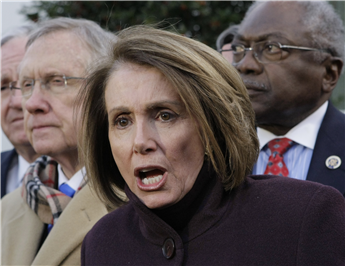By Warren Henry • The Federalist
After almost two weeks of critical media coverage of Joe Biden’s handsy history, poll after poll indicates most Democrats do not care. The latest Quinnipiac poll—of California, no less—has the yet-to-announce Biden easily leading Bernie Sanders and favorite daughter Kamala Harris. This poll also has Harris performing better among white liberals than nonwhite voters.
These findings are mostly news to the progressive elites at the top of Democratic politics and the establishment media. The data suggesting the Democratic Party is an upstairs/downstairs coalition in which a small faction of disproportionately white progressives dominate a more diverse rank-and-file has been piling up in studies by More in Common, Pew, and Gallup. In recent days, some in the media have finally begun to notice.
At The New York Times, resident propellerheads Nate Cohn and Kevin Quealy find that “[t]oday’s Democratic Party is increasingly perceived as dominated by its ‘woke’ left wing. But the views of Democrats on social media often bear little resemblance to those of the wider Democratic electorate.” They add: “The outspoken group of Democratic-leaning voters on social media is outnumbered, roughly 2 to 1, by the more moderate, more diverse and less educated group of Democrats who typically don’t post political content online.”
Cohn and Quealy report that approximately a quarter of Democrats are progressive ideologues; only a tenth might identify as democratic socialists. “The rest of the party is easy to miss,” they write. “Not only is it less active on social media, but it is also under-represented in the well-educated, urban enclaves where journalists roam.”
Similarly, Third Way—a group representing centrist Democrats—has released a poll finding a similar chasm between the woke mob on social media and other Democrats: “On the question of whether Democrats want a candidate who will appeal to a broad range of voters or move left to energize progressives and liberals, voters who do not post on Twitter prefer broad appeal by 57 points, while active Tweeters prefer broad appeal by a much narrower 27 points.”
CNN data guru Harry Enten observes, contra the conventional wisdom, moderates and conservatives still make up roughly half of Democratic voters, while only 19 to 25 percent consider themselves “very liberal.” Moreover, “Millennials and Generation Z voters (roughly those younger than 40)… made up just about 29% of all Democratic voters in the 2018 midterm, per Catalist [a firm that maintains a voter database for Democratic and progressive causes].” Voters over fifty constituted 56 percent of Democratic voters in 2018.
Enten further reports that while Democrats are becoming more likely to have a college degree, almost 60 percent of those who voted in 2018 did not. He adds that “[e]ven among white Democrats… Catalist calculates the percentage of 2018 Democratic voters without a college degree at about 54%, compared to 46% who had a college degree.”
Enten’s analysis tracks that of Ruy Teixeira, a senior fellow at the Center for American Progress best known for having co-authored “The Emerging Democratic Majority,” which convinced so many on the left that demographics was destiny. Early this year, Teixiera and his colleagues found that “2016 voters were 44 percent white non-college and just 30 percent white college-educated…This suggests the exit polls were not just wrong but massively wrong, especially in the context of Rust Belt swing states, where errors were even larger and the political implications of misunderstanding graver.”
Teixiera later expanded on the implications of the exit poll distortions: “This is especially worrisome because white non-college voters remain a larger group than white college voters in almost all states — and are far larger in the Rust Belt states that gave the Democrats so much trouble in 2016: Iowa is 62 percent white non-college versus 31 percent white college; Michigan is 54 percent white non-college versus 28 percent white college; Ohio splits 55 percent to 29 percent; Pennsylvania 51 percent to 31 percent; and Wisconsin 58 percent to 32 percent.”
The woke are not only dismissive of white working-class voters, but also (ironically) of the black voters who may be crucial to the 2020 Democratic presidential nomination. As Enten observed in another analysis, “black voters make up about the same part of the Democratic Party as two parts that a lot of analysts like to hype for their growing power (college-educated white voters and very liberal voters).” Black voters also often act as a bloc, a key to Barack Obama edging out Hillary Clinton in 2008, and to Clinton defeating Bernie Sanders in 2016.
Both Enten and Dan McLaughlin have emphasized the degree to which Southern states will dominate the Democratic primaries after Iowa and New Hampshire. This is where, as Cohn and Quealy map it, “the rest of the party” lives and votes. The calendar will boost the clout of more moderate, establishmentarian Democrats, both black and white.
Despite the mounting evidence, it remains easy to find pundits peddling the narrative that Democrats cannot wait to vote for a socialist or an identity politician to be their standard-bearer in 2020. On a recent edition of NBC’s “Meet The Press,” Anna Palmer and Jake Sherman of Politico were pushing the line that Biden was in trouble (he isn’t), while progressive think tanker Heather McGhee did not think “Biden represents the kind of change particularly that younger voters, who are the biggest bloc in 2020 [they likely aren’t], need to see.”
More broadly, outlets like TIME and Newsweek continue to stick Reps. Alexandria Ocasio-Cortez and Ilhan Omar on their covers as the faces of the Democratic Party:
In fairness, the Democrats are a few percent more leftward and a few percent more credentialed than in past cycles, due largely to younger Democrats growing into adult voting behavior. But it’s still closer to your parents’ Democratic Party than the woke on social media and cable news believe. The woke may be in for a rude awakening.
